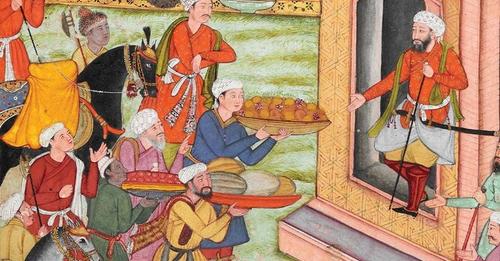:focal(450x300:451x301)/https://tf-cmsv2-smithsonianmag-media.s3.amazonaws.com/filer_public/de/e0/dee02f4b-9440-41d5-9038-582524a98ada/untitled-4.jpg)
British Library / Alamy
Zahiru’d-din Muhammad Babur (1483-1530), the founder of South Asia’s Mughal dynasty, believed that wooing allies was as important as fighting battles when it came to building an empire. With no finer way to win friends than over a good meal, his memoir, The Babur-nama (a plate from a 1590 illustrated version, left), is full of references to parties and picnics, replete with wine and fruit syrups, goose kebabs, “loaves of fine flour” and “plenty of sweet melons.”
Babur’s epicureanism was part of a longstanding culture of feasting in the Islamic world. “So much of Islamic art is related to the sourcing, preparation, serving and consumption of food,” notes Linda Komaroff, curator of “Dining with the Sultan,” a new exhibition at the Los Angeles County Museum of Art that brings together some 250 objects dating from the 7th to the early 20th centuries, presented in the context of culinary and dining traditions. They include a cookbook published in 13th-century Tehran, ornate brass trays, jade dishes and jeweled spoons, and an entire 18th-century reception room salvaged from a Damascus mansion.
“I think food is a good way of introducing an American museum audience to a different culture,” says Komaroff, who strove to make the show a multisensory experience. Guests will be invited to seat themselves on fancy cushions for a “virtual feast” and to sniff scent boxes stocked with cardamom, rosewater, orange blossoms and other heady aromas. Komaroff anticipates they will leave with their appetites thoroughly stimulated. “I think it’s good for people to be hungry.”
/https://tf-cmsv2-smithsonianmag-media.s3.amazonaws.com/filer_public/24/44/24443f7a-9b48-46e8-b96f-50f87942dd3c/rsm73_5_413-dl001-20180410-access_1.jpg)
© Museum Associates/LACMA
/https://tf-cmsv2-smithsonianmag-media.s3.amazonaws.com/filer_public/88/1d/881d54d1-7134-4d65-8667-6759df9fd94c/rsm2021_94-20220810-access.jpg)
© Museum Associates/LACMA
/https://tf-cmsv2-smithsonianmag-media.s3.amazonaws.com/filer_public/82/97/82978dd7-a456-438a-a819-f3ec58aef8fc/new_new.jpg)
British Library / Alamy

/https://tf-cmsv2-smithsonianmag-media.s3.amazonaws.com/filer_public/4f/df/4fdf6eb6-84ac-417d-b362-acd854814dbc/microsoftteams-image_2.png)